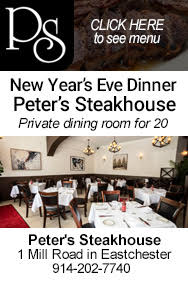Yonkers Zoning Board Grants Brooklands Variance to Build New 1,000-Foot Flood Wall

Mar. 5, 2014: After fourteen months of hearings and presentations before the City of Yonkers Zoning Board of Appeals, Brooklands cooperative, at the corner of Palmer Road and Kimball Avenue, received the variance needed to build a flood wall along the Sprain Brook.
The February 18 decision by the Yonkers board will allow Brooklands to build a 1,000-foot wall in hopes that it will hold back floodwaters of the magnitude that inundated the property in 1972, 2007, and during Hurricane Irene in 2011. According to Kerry Smith, Brooklands board president, through the years the complex has suffered over $8 million in losses from flooding that the current 600-foot wall, built by the state in 1958 to contain the Sprain Brook, could not contain.
Smith stated that the new L-shaped wall will be four feet higher than the existing wall along the Sprain Brook. He noted that the three-foot-high segment along Palmer Road will be covered with grass and virtually unnoticeable.
A six-foot limit on fence height sent Brooklands to the zoning board of appeals in search of permission to build higher. Smith described the appeal as "the gateway" for some neighboring communities to express their own concerns about flooding that the new wall might cause.
"They figured that since we turn into a big pond full of water here," Smith said, "that if we don't have that pond here, the water would flow back to them. But water doesn't flow uphill and it doesn't flow backwards."
Brooklands sits between the Bronx River and the Sprain Brook, which meet just south of the cooperative's V-shaped 6.72-acre property. Engineers hired to analyze the flooding situation and the wall's effects on neighboring communities performed computer modeling and analyses of the history of rainfall, the volume of water, and the rate of flow in both the river and the brook.
Smith explained that the studies showed that, in terms of cubic volume, the watershed drainage for the Bronx River is five times larger and faster than that of the Sprain Brook. Water flowing down the Bronx River tends to back up at Yonkers Avenue in Mount Vernon, causing the Bronx River to subsume the Sprain Brook and flood Brooklands.
Results of the engineering studies showed that, if the Bronx River floodwaters did not accumulate at Brooklands, one one-thousandth of an inch of water would flow to neighboring communities. Although parties opposing the wall did not challenge the findings, Smith said, Brooklands hired an independent third-party engineering consultant to conduct a peer review of the findings. That review confirmed the original conclusion that the wall would create a negligible effect on nearby areas.
Smith estimates that, at the soonest, construction can begin on the new $1 million wall in early to mid-April.
Pictured here: The current wall at Brooklands.
Photo by A. Warner
Government & History Directory
Bronxville is a quaint village (one square mile) located just 16 miles north of midtown Manhattan (roughly 30 minutes on the train) and has a population of approximately 6,500. It is known as a premier community with an excellent public school (K-12) and easy access to Manhattan. Bronxville offers many amenities including an attractive business district, a hospital (Lawrence Hospital), public paddle and tennis courts, fine dining at local restaurants, two private country clubs and a community library.
While the earliest settlers of Bronxville date back to the first half of the 18th century, the history of the modern suburb of Bronxville began in 1890 when William Van Duzer Lawrence purchased a farm and commissioned the architect, William A. Bates, to design a planned community of houses for well-known artists and professionals that became a thriving art colony. This community, now called Lawrence Park, is listed on the National register of Historic Places and many of the homes still have artists’ studios. A neighborhood association within Lawrence Park called “The Hilltop Association” keeps this heritage alive with art shows and other events for neighbors.
Bronxville offers many charming neighborhoods as well as a variety of living options for residents including single family homes, town houses, cooperatives and condominiums. One of the chief benefits of living in “the village” is that your children can attend the Bronxville School.
The Bronxville postal zone (10708, known as “Bronxville PO”) includes the village of Bronxville as well as the Chester Heights section of Eastchester, parts of Tuckahoe and the Lawrence Park West, Cedar Knolls, Armour Villa and Longvale sections of Yonkers. Many of these areas have their own distinct character. For instance, the Armour Villa section has many historic homes and even has its own newsletter called “The Villa Voice” which reports on neighborhood news.
Link to Village of Bronxville One Square Mile Monthly Newsletter
Village of Bronxville Administrative Offices
337-6500
Open 9:00am - 4pm excluding holidays and weekends
Bronxville Police Department
337-0500
Open 24 hours
Bronxville Parking Violations
337-2024
Open 9:00am - 4pm excluding holidays and weekends
Bronxville Fire Deparment
793-6400













